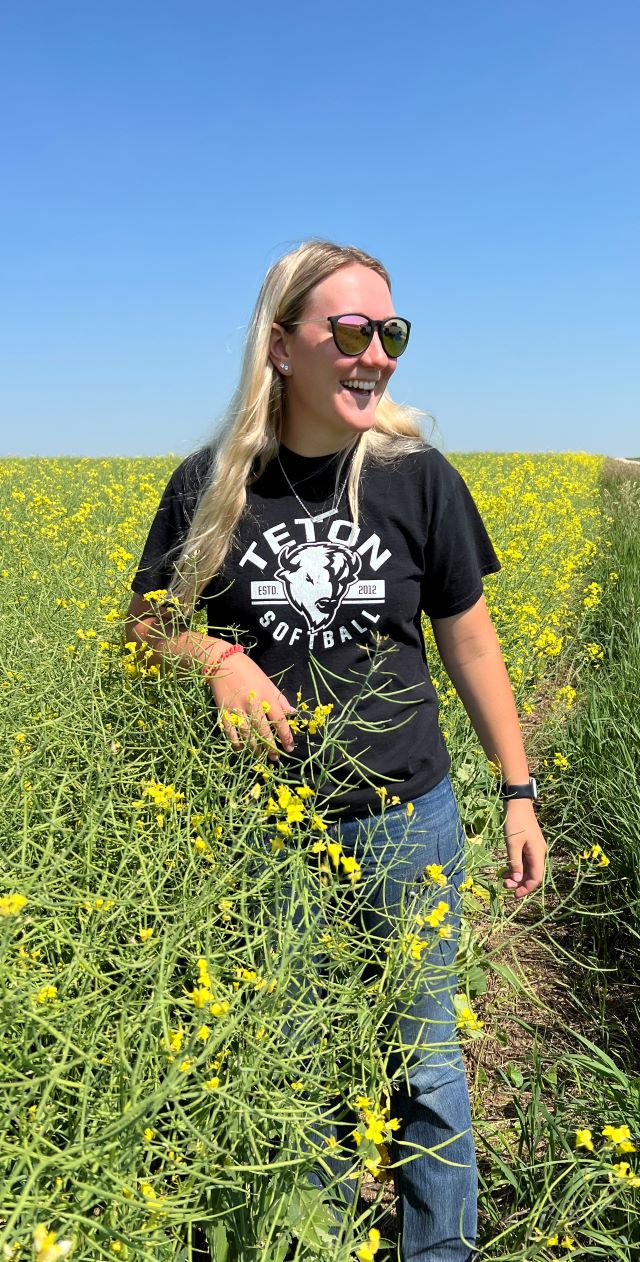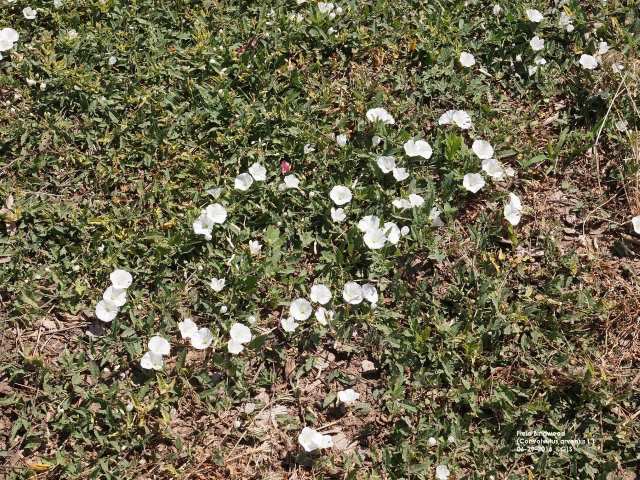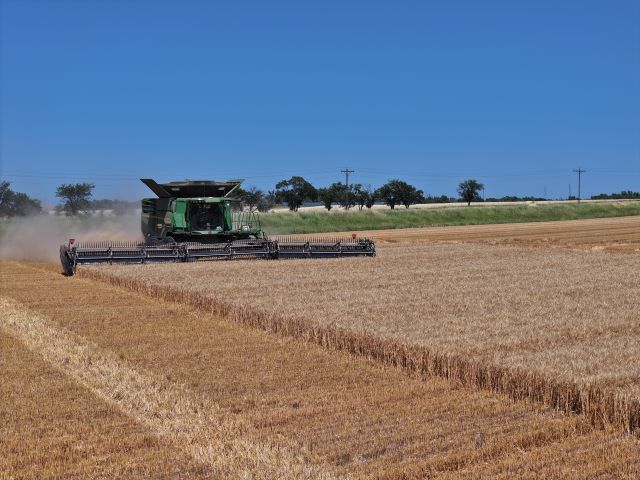Agronomy Update
Aug 12, 2024
Goodbye and Good Luck Abby!
The Williston Agronomy location will be saying goodbye this week to their summer intern, Abby Uffelman, as she heads off to South Dakota State University to pursue a Bachelors degree in Ag Science.Abby was an invaluable member of the team this summer helping in the front office, the warehouse, and with crop scouting. Abby helped Sara identify weeds and stage crops for early season weed spray and assisted Audrey in testing for soil pathogens and root rot. We are truly thankful for the excellent work Abby did this summer and wish her the best of luck this school year.
Thank you Abby, you will be missed!
Williston Agronomy Team

Cover Crops in Western ND
While cover crops are known to provide many soil health benefits, their adoption is challenging in our area due to low rainfall and the potential negative impact they could have on moisture availability for the following crop. That said, folks interested in building soil organic carbon on their farm might still consider planting cover crops, particularly in a scenario where they can be used as forage, grazing or where they would be replacing fallow.In a 10 year cropping systems study conducted by Dr. Perry Miller, Research Agronomist at Montana State University, he found that fallow consistently led to soil organic carbon loss whether in a no-till or tilled system. CRP (0.24 mg/ha/year) and continuous wheat (0.13 mg/ha/ year) built the most organic matter, with rotations including broadleaf crops (wheat/pea/canola) building slightly less (0.09 mg/ha/year). This is purely due to the carbon to nitrogen ration in the different plant species and the residue they leave behind.
Our broadleaf crops provide other important benefits to the rotation like nitrogen fixation and round up ready/liberty link weed management technology and allow farmers to take advantage of different markets. Continuous wheat rotations have led to problems with herbicide resistant green foxtail and wild oat in our area, so its probably not our best option to build soil carbon. A forage/ full season cover crop might give you an opportunity to achieve this while providing other benefits like weed competition into the fall and reducing compaction.
If you are interested in cover crops, Buffalo Brand Seed has several options available for both fall and spring planted cover crops and forage mixes. We can also order you a custom mix. If peas and lentils are in your crop rotation, you probably want to skip those in your forage/cover crop mix to prevent root disease issues. See the attached cover crop guide for more information or the Buffalo Brand Seed website.

The Bindweed Battle
A few weeks ago, I mentioned a product that we have been using to help out with controlling bindweed or creeping jenny and I will explain this product a little more since we are getting close to the timing for spraying bindweed.Bindweed is a really tough weed to control in our fields, especially once it has an established root system. It is a perennial weed that reproduces by seed production, rhizomes or roots. Cultivation will stimulate root growth and a plant can regrow from just one inch of root left in the soil. If left untreated and uncontrolled, the roots and rhizomes can become a mass of 2 to 5 tons per acre in the top 1 to 2 feet of soil. Roots can reach as far down as 20 ft, and up to 25 ft laterally. One plant can produce up to 500 seeds and seeds can stay viable in the soil for up to 50 years. This weed does not just disappear, and a lot of people don’t even notice it until they raise a pulse crop and have to untangle it from their combine at harvest.
Bindweed can become an absolute nightmare in a pulse crop rotation, so you will need to be on top of it and try to keep it under control in your cereals. If you are using paraquat to desiccate your pulse crops, this is a weed that you will have a tough time getting dried down since paraquat is strictly a contact herbicide and when the target is a vine, you will have a tough time getting enough water and chemical on this plant to do enough good. For the growers that want to keep their options open for raising a pulse crop the next year, there is no answer for you that will actually kill bindweed and let you rotate to a pulse crop. Bindweed and pulse crops are just not a good combination, and you are better off raising a cereal or a crop that you can actually get some weed control in.
For chemical weed control, we have been using a product that has been around for many years and was originally marketed by Monsanto.
Landmaster BW is a combination of glyphosate and 2,4-D Amine along with their surfactant load to help get the product into the plant. I can tell you exactly how many ounces per acre of glyphosate and how many ounces of 2,4-D to spray per acre to make the equivalent of the rate we are using with Landmaster BW and it just will not work as well as Landmaster BW. Maybe if we use a high-quality surfactant like Last Chance that is similar to the surfactants used in the higher tier glyphosate products like Roundup Weathermax it might perform better, but we have not been able to duplicate the efficacy we have seen with the Landmaster BW. When Monsanto originally marketed this product, it was targeting bindweed and that is what the BW referred to…..bindweed.
As far as timing, the creeping jenny or bindweed will dry up or brown up and will not take chemical into the plant as late as Canada Thistle will, so you want to spray Landmaster BW as soon as possible after harvest while the plant is still green and growing. This product is also labeled for pre-harvest in wheat, but the rates are about half of our recommended rate we are spraying post-harvest, so I don’t expect the same weed control. With the high rates of 2,4-D in this product, it is probably not a good idea to take a chance on pulse crops next spring, but with bindweed problems, pulse crops are not the best choice to begin with as it would be tough to get 100% control in one application. If you have any questions on Landmaster BW or how to control bindweed, please contact one of our Agronomists and we will get you going in the right direction.
John Salvevold, Agronomy Division Manager, CCA

Herbicide Resistant Kochia
The National Agricultural Genotyping Center (NAGC) located in Fargo, ND is a non-profit lab that conducts various genetic testing for agricultural applications. They recently released a test that can determine if kochia or pigweed is resistant to Group 14 herbicides, glyphosate (Group 9), or Group 2 herbicides. The test is convenient as you only have to mail in a few leaves from a plant suspected of being resistant and the results are returned in a week or two. For wild oat and foxtail, we still have to rely upon our NDSU weed scientists to plant out seeds and spray them to test for resistance. Hopefully a DNA based test will be coming soon for those weeds.This summer I tested kochia from eight fields in Williams and McKenzie County for herbicide resistance. I detected Group 14 resistance in five of the fields, glyphosate resistance in all of the fields, and Group 2 resistance in six of the fields.
So what does this mean? Do we need to stop using these herbicides to manage kochia? The answer is no, we should still use these products, but we do need to be adding other groups to the mix. If you read my article on fungicide resistance last week, I described how resistance develops and it is the same for weeds. Out in a field there will be a population of plants with each individual in that population having different genetic mutations and sensitivity to herbicides. My test results reflect this. Some kochia individuals were resistant to all three herbicide groups, some were resistant to two, some were resistant to only one and some were sensitive to all three. What this means for management is that there are still sensitive plants out there, and we need to manage the populations to make sure we are killing resistant ones and maintaining a level of susceptibility in the population. Maybe we won’t get them all, but as long as we continue to throw the kitchen sink at our kochia instead of relying on just one mode of action over and over, we should be able to manage resistance.
In future articles we will discuss in more detail what your options are for fall weed control, which will be essential for managing resistant kochia, marestail and narrowleaf hawksbeard. If you want kochia in your fields tested for resistance, reach out to our agronomy locations to get that set up.
Dr. Audrey Kalil, Agronomist/Outreach Coordinator
Submit Maps for Soil Sampling
Soil Sampling will be starting soon and we will be offering conventional and zone sampling again this year. When dropping off maps, please include the 2024 crop and possible crops for next season.Don’t wait until October to drop off your maps if you would like your fields to be soil sampled. The sooner we have them, the sooner they will be done!
Sara Erickson, Agronomist
National Wheat Yield Contest (NWYC)
Although the deadline to sign a field up for the NWYC contest has passed for spring and winter wheat this year, I want to share my experience helping one of my farmers submit an entry for the contest. The National Wheat Foundation (NWF) created the NWYC less than 10 years ago as a means for wheat growers to enter their crop at a national level to see how their crop measures up against others. This contest to me is unique because you enter for your specific class of wheat: hard red winter, hard red spring, soft red winter, soft white winter, and it’s split between dryland and irrigation. The argument can be made that someone in Grand Forks County will always beat someone in Williams County when it comes to dryland yields, BUT the metric isn’t just the bushels per acre yield you can raise, its about how much better you can produce that crop over your county T-yields. Which means yield winners by state are chosen by who produces the highest yield measured in a percentage over their county averages. This means anyone can be a contender for the contest.The contest isn’t overly complicated to participate in, the cliff notes are you must enter a field planted with new certified seed, the field is larger than 5 acres, and area harvest for the yield entry must be 1.5 acres of larger in one contiguous area. If you want to read the full rules you can click this link.
This was a first for both of us this year submitting an entry into this contest, so all we did was decide which field we would have him enter and which part of the field we would take the 1.5 acres for the NWYC entry. No special fertility, products, or fungicides outside of the normal practice. Choosing the area, we would predict would be best was a combination of mining yield history and looking up current years satellite imagery to find the intersect of highest yield and highest biomass this year in that field. This was a fun practice because it pointed out the best areas in the best zones of the field and made us both think what it is exactly about these specific areas that do so much better than the rest of the field: is it organic matter, soil type, soil texture, organic matter, pH, or other fertility.
Now we’re both looking ahead to next year thinking about the things we can try to improve on that can enhance yield. It’s only 1.5 acres, so the cost to try new things are miniscule if they do not improve yield. BUT…the upside is, if we do find a new practice, whatever that may be, that improves yield in future years, we analyze was that a profitable input decision and if so, could it be implemented across the farm’s wheat acres.
My point of sharing this story with you all is this farmer and me as his consultant are thinking critically about how to improve his wheat’s bottom line and that’s a win for everyone. I highly recommend any of you try to participate in the NWYC because it will get you thinking differently about your farm.
Kyle Okke, Crop Consultant, CCA
